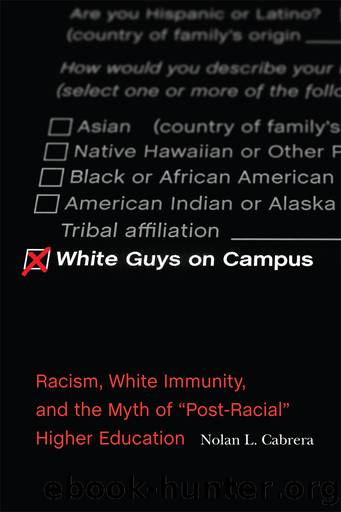White Guys on Campus by Nolan L Cabrera

Author:Nolan L Cabrera [Cabrera, Nolan L]
Language: eng
Format: epub
Tags: Social Science, General, Discrimination, Education, Inclusive Education, Higher, Multicultural Education, Gender Studies, Men's Studies
ISBN: 9780813599083
Google: ay5SDwAAQBAJ
Publisher: Rutgers University Press
Published: 2018-11-15T05:25:18+00:00
âMinorities Took Over the Student Council, So We Took It Backâ: The Example of Roger
Roger was very involved on campus and was concurrently frustrated by what he saw as a community fractured along racial/ethnic lines. Like Trevor, it was very telling where he placed blame for this phenomenon. He began by offering, âI think race relations on campus are poor at WU largely because while there is a diverse view within the student population, there isnât very good integration of that diverse population.â Roger then offered his explanation as to why the community was so divided:
It is absolutely the case that minorities self-segregate. If it wasnât there wouldnât be a number of clubs that identify solely by ethnic background. There wouldnât be a MEChA. There wouldnât be an African Student Union. There wouldnât be an Asian Pacific Coalition, a Samhan, a Filipino, a Vietnamese Student Union, and a this and a that and the other thing. Even within the queer community at WU the queer community or the queer alliance is a number of ethnic queer organizations that come together. Mishpacha is the Jewish queer organization. Thereâs Blaq with a âq.â Thereâs La Familia, which is the Latino/Latina. Thereâs Mahu, which is the API, Asian/Pacific Islander queer organization on campus. So, there are.⦠Thereâs this massive self-segregation.
It was telling not only whom Roger mentioned in this impressive list, but also whom he left out. Specifically, he never mentioned groups that have predominantly White populations as being responsible for campus self-segregation. Instead, he thought that blame fell squarely on Students of Color. Roger was very direct on that point: âI donât know of a White Student Association.â It was from this orientation that Roger described his involvement in his universityâs student government.
Roger began by saying, âIâm also part of [slateâs name], which is one of two major parties in student government. Itâs the party that is the less ethnocentric of the two parties.â This frame was telling because he did not see his largely White group as being âethnocentric.â It was, in his understanding, the group of Students of Color who gained control of the student government about a decade earlier were the ones being ethnocentric. Roger offered a historical perspective: âOne of the interesting phenomena thatâs occurred here and this is one of the reasons that Iâm so involved in the student government is about the same time that Prop 209 was introduced a number of student organizations on campus got together and created the first student government political parties at this university.3 It used to not be so political. It used to be that not really anyone wanted to do it and a few people had a popularity contest. And it was kind of heavily Greek dominated by like the fraternity/sorority system.â This was a fascinating intersection of race and space. For Roger, student government was not political when it was âdominatedâ by Greek members who were also heavily White and affluent. He never expressed any discomfort at White
Download
This site does not store any files on its server. We only index and link to content provided by other sites. Please contact the content providers to delete copyright contents if any and email us, we'll remove relevant links or contents immediately.
| Behavioral Disorders | Communicative Disorders |
| Gifted Students | Inclusive Education |
| Learning Disabled | Mentally Disabled |
| Physically Disabled |
The Art of Coaching Workbook by Elena Aguilar(51069)
Trainspotting by Irvine Welsh(21564)
Twilight of the Idols With the Antichrist and Ecce Homo by Friedrich Nietzsche(18563)
Fangirl by Rainbow Rowell(9170)
Periodization Training for Sports by Tudor Bompa(8209)
Change Your Questions, Change Your Life by Marilee Adams(7676)
This Is How You Lose Her by Junot Diaz(6829)
Asking the Right Questions: A Guide to Critical Thinking by M. Neil Browne & Stuart M. Keeley(5705)
Grit by Angela Duckworth(5553)
Red Sparrow by Jason Matthews(5421)
Paper Towns by Green John(5136)
Room 212 by Kate Stewart(5066)
Ken Follett - World without end by Ken Follett(4680)
Housekeeping by Marilynne Robinson(4390)
The Sports Rules Book by Human Kinetics(4338)
Double Down (Diary of a Wimpy Kid Book 11) by Jeff Kinney(4238)
Papillon (English) by Henri Charrière(4223)
The Motorcycle Diaries by Ernesto Che Guevara(4046)
Exercise Technique Manual for Resistance Training by National Strength & Conditioning Association(4016)
